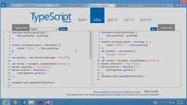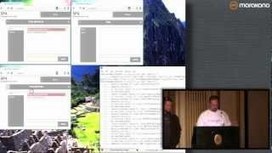JavaScript has grown from a webpage toy to being used in large-scale deployments both on the server and in the browser. This rapid growth has outpaced the growth of the language itself, which lacks features that allow teams to communicate requirements and build applications safely. This session will describe TypeScript, a modern superset of JavaScript built for the needs of modern JavaScript development. We'll explore features in the language and demonstrate how these features work together with tooling to avoid common pitfalls and enable a pleasant developer experience.
Get Started for FREE
Sign up with Facebook Sign up with X
I don't have a Facebook or a X account



 Your new post is loading... Your new post is loading...
 Your new post is loading... Your new post is loading...
Current selected tag: 'Tutorial'. Clear
No comment yet.
Sign up to comment
From
ejohn
This tutorial contains code and discussion from the upcoming book Secrets of the JavaScript Ninja by John Resig. 1) Our Goal Developers creating JavaScript applications these days usually use a combination of MVC, modules, widgets and plugins for their architecture. They also use a DOM manipulation library like jQuery. Whilst this works great for apps that are built at a smaller-scale, what happens when your project really starts to grow? In this talk, I present an effective set of design patterns for large-scale JavaScript (and jQuery) application architecture that have previously been used at both AOL and Yahoo amongst others. You'll learn how to keep your application logic truly decoupled, build modules that can exist on their own or be dropped into other projects and future-proof your code in case you need to switch to a different DOM library in the future.
Jan Hesse's insight:
kinda old but still worth a look to get a refreshed overview Use a T4 template to generate Knockout-viewmodels based on .NET classes. This article describes a solution to this problem by using T4 templates to generate the JavaScript Knockout models automatically based on the .NET classes. The resulting Knockout models are extendable so as to be able to add additional functions and (computed) properties client-side. Finally, I also added an IsDirty feature that can indicate if the model has been modified since it's data was set. The purpose of this JavaScript Training Course, as the name implies, is to cover the details of the JavaScript language. The reason we need this is that JavaScript is a core language for web development, and it is mostly misunderstood. There are many powerful features in JavaScript that many developers are not aware of. Also, learning the core concepts of the language will make libraries such as jQuery easy to understand. We use JavaScript on the client side of our web development to make calculations, create menus, and validate user data before the form is submitted to the server. These are few of the JavaScript features. We will be using Firefox and its tools to test and debug the JavaScript code.
Jan Hesse's insight:
for beginners: 32 chapters all with video explanations JavaScript does not come with dedicated means for managing private data for an object. This post describes five techniques for working around that limitation: * Instance of a constructor – private data in environment of constructor * Singleton object – private data in environment of object-wrapping IIFE * Any object – private data in properties with marked names * Any object – private data in properties with reified names * Single method – private data in environment of method-wrapping IIFE
The following sections explain each technique in more detail. Required knowledge: While everything is explained relatively slowly, you should probably be familiar with environments and IIFEs [1] and with inheritance and constructors [2]. Free video tutorials on programming, mathematics, science and political science.
Jan Hesse's insight:
Links directly to Web Technologies Video Tutorials |
Cargo-cult programming is what a programmer does when he or she doesn't know a particular language or paradigm well enough, and so ends up writing redundant and possibly harmful code. It rears its head quite often in the land of JavaScript. In this article, I explore the concept of cargo-cult programming and places to watch out for it in JavaScript. Cargo-culting is sometimes defined as "the extreme adherence to the form instead of content." The form, in programming, being the syntax, paradigms, styles and patterns that we employ. The content being the abstract thing that you are seeking to represent through your code — the very substance of your program. When using frameworks such as Ember.js, we often find ourselves forgetting the main reason why we chose to use the framework. We don’t do it because it’s cool, or at least we shouldn’t. We don’t do it because somone told us we have to use Ember (unless your boss doesn’t have much brains). We do it because want to make the user experience better. I won’t go into details about server side implementation, this is purely about UX. Ember allows us to do a lot of things quite easily, which leads to the turbo mode of development. This most often happens after watching some cool screencast where they did this cool thing in about 5 minutes, and you start thinking wow I can write my whole app in one day using this technique/framework/library. But the cold truth is, you can’t. Unlike its web development peers, JavaScript has never really had much in the way of frameworks to provide structure. Thankfully, in recent years, that’s beginning to change. Today, I’d like to introduce you to Backbone.JS, a sweet little library that makes the process of creating complex, interactive and data driven apps so much easier. It provides a clean way to surgically separate your data from your presentation. In my previous tutorial, I touched on how to use Ember.Object to define your models and work with datasets. In this section, we’ll look more closely at how Ember uses the Handlebars templating framework to define your app's user interface.
* Getting Into Ember.js - http://net.tutsplus.com/tutorials/javascript-ajax/getting-into-ember-js/ * Getting Into Ember.js: The next steps - http://net.tutsplus.com/tutorials/javascript-ajax/getting-into-ember-js-part-2/ * Getting Into Ember.js: Part 3 - http://net.tutsplus.com/tutorials/javascript-ajax/getting-into-ember-js-part-3/ * Getting Into Ember: Part 4 - http://net.tutsplus.com/tutorials/javascript-ajax/getting-into-ember-part-4/ * Getting Into Ember.js: Part 5 - http://dev.tutsplus.com/tutorials/getting-into-ember-js-part-5--net-35817 Tutorial 4: "Putting the web back into web app"
Tutorial 3: "‘Fixing’ the application cache with an iframe"
Tutorial 2: "Supporting both IndexedDB and WebSQL on a cross platform web app"
Tutorial 1: "How to make an offline HTML5 web app, FT style"
Jan Hesse's insight:
Explains how parts of the FinancialTimes WebApp was made. Welcome to this JavaScript course. |


















